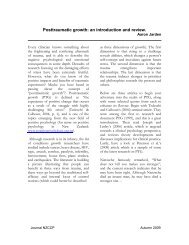The expert therapist - Aaron Jarden
The expert therapist - Aaron Jarden
The expert therapist - Aaron Jarden
Create successful ePaper yourself
Turn your PDF publications into a flip-book with our unique Google optimized e-Paper software.
elationship (Persons et al., 2001). For example, once established, the <strong>expert</strong><br />
position granted <strong>therapist</strong>s a paternalistic „licence to confuse‟ their patients.<br />
Similar to the way doctors regularly converse in medical concepts and<br />
terminology beyond the level of comprehension of their patients, in which the<br />
patient usually acknowledges and accepts, although does not understand, the<br />
terminology or concepts, <strong>therapist</strong>s conversed in concepts and terminology<br />
beyond the level of comprehension of their patients. This subtle paternalism<br />
evident in a doctor‟s non-explanation of complex medical terminology could<br />
also be seen in various aspects of the <strong>therapist</strong>s discourse, for example:<br />
<strong>The</strong>rapist: …the tightening of your intercostal muscles lead to a fear<br />
of not being able to breathe.<br />
However, interestingly, this „structure of rights‟ entailed by the two<br />
positions also seemed equally agreeable to both parties. <strong>The</strong> regular uptake<br />
of both of these positions in actuality laid much of the foundation for the<br />
therapeutic process and subscribed the possibilities for and limitations on<br />
various actions. Hence, these subject positions had considerable implications<br />
for the power relations between the <strong>therapist</strong> and client, as they constrained<br />
and shaped to a large degree what was possible in their therapeutic<br />
relationship.<br />
For the client, there seemed a number of advantages to adopting such a<br />
position. Foremost amongst these were the offset of responsibility onto the<br />
<strong>therapist</strong> to care for the client, and positioning themselves in a more malleable<br />
position from which to allow therapeutic change. For the <strong>therapist</strong>, there also<br />
seemed a number of advantages to adopting the <strong>expert</strong> position. Foremost<br />
amongst these were the instilment of certain powers and responsibilities to act<br />
in a beneficent and non-maleficent way, and the clarifying of boundaries<br />
surrounding what was and could be expected.<br />
Caveat emptor: Three points.<br />
Firstly, the subject positions adopted were particularly hard to discern<br />
given the different types of media and interactional formats utilised. For<br />
example, the identities negotiated seemed slightly different when <strong>therapist</strong>s<br />
were conversing with other <strong>therapist</strong>s (such as in the instructional books), as<br />
compared to conversing with clients (such as in the video demonstrations).<br />
Compounding this element, and as would be expected, the subject positions<br />
adopted also varied as <strong>therapist</strong>s‟ talk changed as a function of their particular<br />
contexts and what they were trying to achieve in particular instances.<br />
Secondly, we have chosen to focus on and present the two most<br />
frequently adopted subject positions („<strong>expert</strong>‟ and „layperson‟) discerned in the<br />
various texts. However, in addition to these, both the <strong>therapist</strong> and client also<br />
adopted a number of other interesting subject positions. <strong>The</strong>se included the<br />
<strong>therapist</strong>s adopting a „friend‟ position in which they befriended their clients,<br />
and a „nursing‟ position in which they cared for their clients. Clients also<br />
adopted a „teachers favourite‟ position in which they sought special treatment<br />
and attention from their <strong>therapist</strong>, and a „hopelessness‟ position in which they<br />
resisted their <strong>therapist</strong>. Nonetheless, these positions were not covered in this<br />
article.<br />
7





